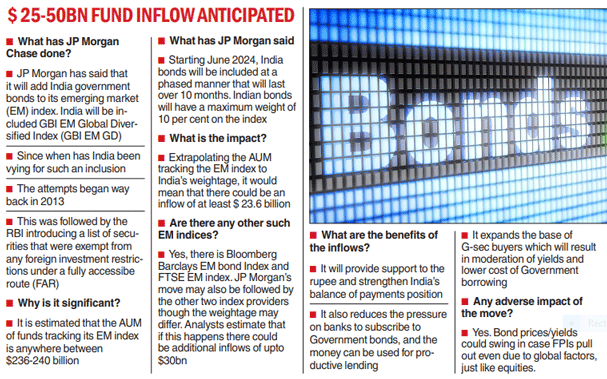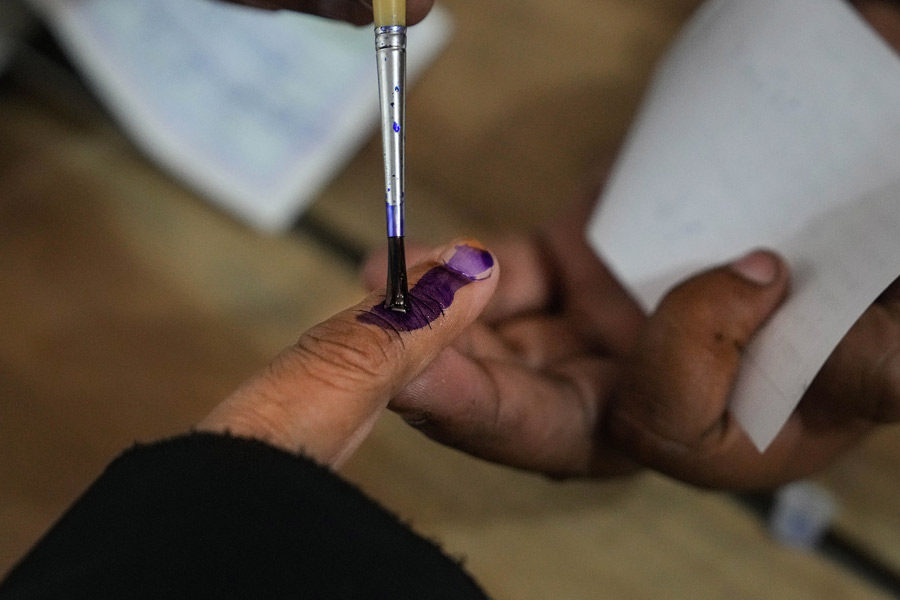India’s sovereign bonds will finally clamber on to the global stage next year.
JPMorgan has said it will include India in its widely-tracked emerging market debt index in June next year — a move that could potentially lead to an inflow of at least $ 24 billion into the world’s fifth-largest economy.
India’s local bonds will be included in the Government Bond Index-Emerging Markets (GBI-EM) index and the index suite, benchmarked by about $236 billion in global funds, JPMorgan said on Friday.
The announcement comes at a time when India is trying hard to raise its standing in
international financial markets.
The inclusion of Indian bonds in the JP Morgan index will begin on June, 28, 2024. The global index provider identified 23 government securities, or G-Secs as they are known in bond market parlance, with a combined notional value of $330 billion that will be eligible for inclusion in the index.
The G-Secs will be added in a staggered fashion over a 10-month period with the inclusion of 1 per cent weight per month. At the end of the period, India is expected to reach a maximum weight of 10 per cent.
The development has stirred hopes that other index providers with EM bond indices will follow suit. These include the Bloomberg Barclays EM bond index and the FTSE EM index.
If this happens, it is estimated that the money flow into India’s debt market could rise by another $20 billion.
The surge in inflows is expected as there are several passive funds that replicate an index.
These funds will start buying Indian government bonds. Active funds are also expected to join them.
Bond yields fall
Both the rupee and government bond markets reacted to the positive surprise from JP Morgan.
The rupee gained 17 paise to close at 82.93 against the US dollar while yields on the benchmark 10-year security declined to a day’s low of 7.07 per cent after the announcement. But profit-booking kicked in and the yield rose to close at 7.15 per cent.
“We continue to expect the 10-year India bond yields to ease down to 6.80 per cent over the coming months (from the current 7.16 per cent),” Citigroup analysts wrote in a note.
According to Gaura Sen Gupta, economist at IDFC First Bank, India is also expected to enter other JP Morgan bond indexes - JADE Global Diversified index, JESG GBI-EM index and other aggregate suite of local currency indexes.
“The AUM (assets under management) of funds tracking JP Morgan GBI-EM family of indices equals $ 236 billion. The index inclusion could result in inflows of $ 23.6 billion into FAR G-Secs starting from next year and completed by April/May 2025.
Foreign portfolio investors’ holdings of outstanding G-secs could rise to 3.4 per cent by April/May 2025 versus 1.7 per cent in September 2024,” Sen Gupta said in a note.
Satyakam Gautam, rates trader at ICICI Bank, felt that active funds were also expected to channel money into Indian G-Secs.
The arrival of more foreign investors into Indian debt will also be beneficial for banks since they can now allocate money to productive lending.
“It provides an alternative source of financing for government borrowings; it opens up the space for corporate issuers, and brings the entire yield curve down significantly once all the inclusions are in place.
“National banks’ balance sheets will also be freed up so that they can allocate more funds to the private sector,” Gautam added. But he felt it also places a significant fiscal responsibility on the Government of India since these flows would be closely tracking its fiscal prudence.
Axis Mutual Fund felt that the sharp increase in fund inflows might prompt the Reserve Bank of India to soak up some of the liquidity.
“We believe the RBI could conduct sterilization operations during this inclusion period buffeting forex reserves and the currency,” it added.
Madhavi Arora, lead economist at Emkay, said the passive and active fund flows into local G-Secs would help India finance its fiscal and current account deficit (CAD) as well as enhance the liquidity and ownership base of G-Secs.











